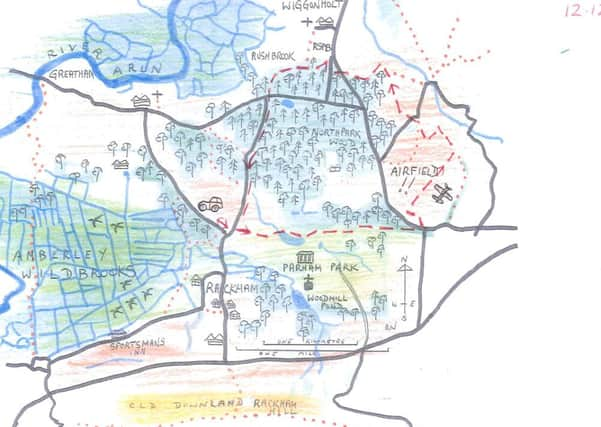RICHARD WILLIAMSON: Country walk: Parham Park to Wiggonholt


I parked roadside near Parham Park’s West Lodge, TQ049147 on the Literary Trail. A footpath runs right across the park for a mile to the East Gate.
Thank goodness for the ancient great estates. Our heritage now for all to see are the sweeping landscapes of centuries past with their ancient trees, herds of deer, mellowed buildings in sympathy with the mighty hills behind.
Advertisement
Hide AdAdvertisement
Hide AdStricken trees are left with their dead timber that is the home for rare insects such as the stag beetle.
Grasslands grazed by the herd of black fallow deer and by sheep, are home to butterflies, flowers and wandering flocks of finches. Green woodpeckers feed on the ants. Tufted ducks and pochards live on the ornamental lakes. Alder trees give shelter to dragonflies.
Mistletoe grows on the lime trees. The park lies across the sandy hummocks left by ice and floods from hundreds of thousands of year before.
In medieval times there were pear orchards around the homes, giving the name Parham.
Advertisement
Hide AdAdvertisement
Hide AdAs I left I noted the cranked chimneys on the West Lodge and the fallow deer’s antlers between ornate barge boards.
A pavement took me safely 50 yards down the A283 then I crossed this road to a green and white footpath sign and I wended my way on to Parham airfield.
Stick to the path straight to the windsock and keep your dog securely on its lead if you try this walk because powered aircraft tow gliders into the air, sometimes continually. My brother used to fly from here, to soar on the downland ridge during northerly winds. It reminded me forcefully of those heady days in the second world war when Lysanders towed target drogues from Langham airfield in Norfolk.
At the northern end of the airfield turn left along the tiny River Stor with its willows and willowherb. Old gallops’ rails can be followed too, then left turn along the hedge with its old magpie’s nest, over a footbridge and into the small oak wood, then crossing the minor road and on to the track to Redford House.
Advertisement
Hide AdAdvertisement
Hide AdI counted 13 shrub and tree species in the hedge, giving an age of perhaps one millennium. I plunged down a sandy ravine, kept straight ahead at the crossways and then wended my way left around the lake with all its mallard and CCT warnings. Who is frightened of what, I asked myself.
I crossed the A283 again, then a minor road, and without the help of any direction post found the famous viewpoint on RSPB land that overlooks the heath and beyond into Pulborough Brooks.
There are six seats provided here to rest one’s weary legs, but make sure you choose one out of the wind.
Leave the hill and follow the RSPB directional maps south-westward, to the minor road past Sparrite Farm back to the car through these pleasant birch and pine and oak woods.